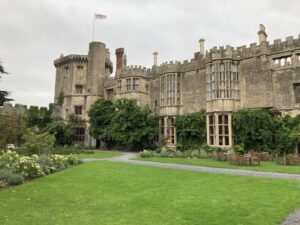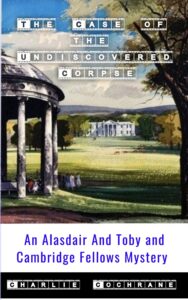 Imagine a castle. A castle that was confiscated by Henry VIII after he’d chopped off the owner’s head. A castle that may not have been “knocked abaht a bit” by Cromwell, but which went seriously downhill after the civil war. One that was restored in the 19th century and may—rumour has it—have been where they hid the crown jewels during World War Two. Sounds interesting, doesn’t it? Better still, it’s a place where you can stay because it’s now a hotel, so it provides a tremendous venue for an author who writes historical novels and who wants both inspiration and an opportunity for immersive research. That’s my story about why we’ve stayed there several times and I’m sticking to it.
Imagine a castle. A castle that was confiscated by Henry VIII after he’d chopped off the owner’s head. A castle that may not have been “knocked abaht a bit” by Cromwell, but which went seriously downhill after the civil war. One that was restored in the 19th century and may—rumour has it—have been where they hid the crown jewels during World War Two. Sounds interesting, doesn’t it? Better still, it’s a place where you can stay because it’s now a hotel, so it provides a tremendous venue for an author who writes historical novels and who wants both inspiration and an opportunity for immersive research. That’s my story about why we’ve stayed there several times and I’m sticking to it.
There’s nothing better than experiencing the era you write about, albeit at several removes. Work a sash window and see how tricky—and draughty—they can be. Trot up and down a spiral staircase and discover how that fight scene you had in your mind could physically never work. Stand next to a thick stone wall and see how much cold the thing radiates. While none of the detail might make its way into your story, it’ll give you a clearer idea of what your characters experienced in their everyday lives and why, for example, people wore bed socks and night caps, because their rooms would have been so flipping freezing.
 Research is little use unless it turns into or backs up a story, so inspiration for what that story will be is the other factor writers can find when on the road. The Cochrane family first stayed at Thornbury Castle back in 2006, which was just before I started work on my first murder mystery. I needed a family home for Jonty Stewart—one of my pair of amateur sleuths—and it was obvious that Thornbury had to provide the template for it. I could so clearly see the characters occupying the place in its new guise as The Old Manor, especially the glorious walled garden which is a little jewel of colour and tranquillity. That garden was the setting for some significant scenes, and the strange grey cat we encountered there had to be incorporated, especially when the staff said he didn’t belong to the hotel or to any of the local houses. This mysterious moggy became a ghost cat who had inhabited The Old Manor since the time of Shakespeare and may just have been the “harmless, necessary cat” the Bard refers to in The Merchant of Venice. A small thing, maybe, but the kind of element that can enrichen a story and provide a useful thing for your characters to chat about while you’re fleshing them out.
Research is little use unless it turns into or backs up a story, so inspiration for what that story will be is the other factor writers can find when on the road. The Cochrane family first stayed at Thornbury Castle back in 2006, which was just before I started work on my first murder mystery. I needed a family home for Jonty Stewart—one of my pair of amateur sleuths—and it was obvious that Thornbury had to provide the template for it. I could so clearly see the characters occupying the place in its new guise as The Old Manor, especially the glorious walled garden which is a little jewel of colour and tranquillity. That garden was the setting for some significant scenes, and the strange grey cat we encountered there had to be incorporated, especially when the staff said he didn’t belong to the hotel or to any of the local houses. This mysterious moggy became a ghost cat who had inhabited The Old Manor since the time of Shakespeare and may just have been the “harmless, necessary cat” the Bard refers to in The Merchant of Venice. A small thing, maybe, but the kind of element that can enrichen a story and provide a useful thing for your characters to chat about while you’re fleshing them out.
 Real life occurrences can spark a fictional equivalent, too. That rumour about the crown jewels being stored at Thornbury Castle…where would you hide such valuables? In a hidden vault, surely. What else could you hide there? A body. All of a sudden there’s a story up and running. In my case, it inspired the cosy mystery The Case of the Undiscovered Corpse, which is part of my 1950s Alasdair and Toby series. (Imagine two actors who play Holmes and Watson onscreen and off and you’ve got the idea.)
Real life occurrences can spark a fictional equivalent, too. That rumour about the crown jewels being stored at Thornbury Castle…where would you hide such valuables? In a hidden vault, surely. What else could you hide there? A body. All of a sudden there’s a story up and running. In my case, it inspired the cosy mystery The Case of the Undiscovered Corpse, which is part of my 1950s Alasdair and Toby series. (Imagine two actors who play Holmes and Watson onscreen and off and you’ve got the idea.)
I’d always advise aspiring authors to keep their eyes and ears open and their imaginations ready to be launched, whether they’re on their travels or simply in the local supermarket. So often I hear fellow authors talk about the tiny seeds—a snatch of conversation overheard, an interaction observed or a place visited—which have subsequently developed into full-grown stories. Be alert!
Link: https://www.amazon.co.uk/Undiscovered-Alasdair-Cambridge-Fellows-Mystery-ebook/dp/B0BHLN5HB8

Pingback: Charlie’s latest newsletter – Charlie Cochrane – Mysteries with a dash of slash, romances with just a pinch of spice
Pingback: Writers on the Road guest spot – Charlie Cochrane – Mysteries with a dash of slash, romances with just a pinch of spice
Thanks for hosting me!